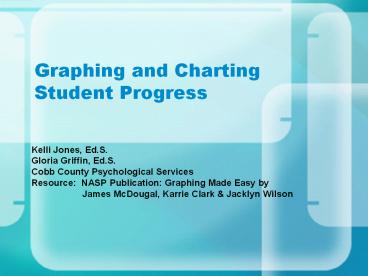Graphing and Charting Student Progress - PowerPoint PPT Presentation
1 / 15
Title:
Graphing and Charting Student Progress
Description:
Visually summarize information ... Presenting Visual Data FIDELITY Graphs are only as accurate as the information used to construct them Collecting ... – PowerPoint PPT presentation
Number of Views:100
Avg rating:3.0/5.0
Title: Graphing and Charting Student Progress
1
Graphing and Charting Student Progress
- Kelli Jones, Ed.S.
- Gloria Griffin, Ed.S.
- Cobb County Psychological Services
- Resource NASP Publication Graphing Made Easy
by - James McDougal, Karrie Clark
Jacklyn Wilson
2
Why Graph Data?
- Visually summarize information
- - displays data to others easily
- - establishes a common language, encouraging
open discussion - - student performance
- - projected performance
- - actual performance as it changes
- over time
- - can compare results to peers
3
Why Graph Data
- - can be easily included in reports, printed for
meetings, emailed - - sharing data during intervention phase can
shape perceptions of effectiveness of the
intervention and student progress - - measure of professional
accountability
4
Why Graph Data
- Allows the team to determine whether modification
of an intervention is needed or when a new
intervention design is indicated
5
Presenting Visual Data
6
FIDELITY
- Graphs are only as accurate as the information
used to construct them
7
Collecting Data
- RTI Documentation
Area of Difficulty including curriculum areas or behavioral concerns Area of Difficulty including curriculum areas or behavioral concerns Area of Difficulty including curriculum areas or behavioral concerns
Evidence Based Intervention(s) Provided Evidence Based Intervention(s) Provided Evidence Based Intervention(s) Provided
Baseline Performance Data Date Result Baseline Performance Data Date Baseline Performance Data Date Result
Results of Intervention Results of Intervention Results of Intervention Results of Intervention Results of Intervention
Data Point 1 Date Result Data Point 1 Date Result Result
Data Point 2 Date Result Data Point 2 Date Result Result
Data Point 3 Date Result Data Point 3 Date Result Result
Data Point 4 Date Result Data Point 4 Date Result Result
8
Collecting Behavioral Data
- Attention/Emotional
- - time off task-- or
- occurrences
- - work completion- can
- use Pinnacle data e.g.
- - absences
- - visits to clinic/counselor
9
Collecting Behavioral Data
- External Behaviors
- - how often actual
- - how long does it last
- i.e.minutes
- - intensity (rate 1-5)
10
Collecting Academic Data
- Reading
- Fluency words correct per minute
- Decoding- words read correct
- Comprehension questions correct
11
Collecting Academic Data
- Math
- Calculations - facts completed in minutes
- Concepts - can use test and quiz scores over
time
12
Written Expression
- Writing samples
- Using story starter, allow three minutes. Score
using a predetermined rubric - e.g. Correct words per minutes, sentences
written, punctuation errors - OR
- e.g. Scale 1. significantly below , 2.
somewhat below, 3. at level, 4. above peers
13
EXCEL DATA PREVIEW
Date correct errors goal
BL 9/1 25 4
8-Sep 24 3 30
15-Sep 26 3 35
22-Sep 28 3 40
29-Sep 31 4 45
14
Presenting Visual Data
15
RESOURCES
- http//www.oswego.edu/mcdougal/web_site_4_11_2005
/index.html - Can download all templates for use































